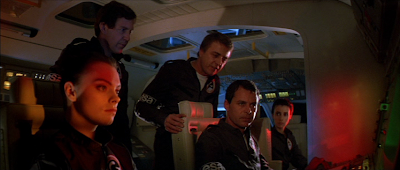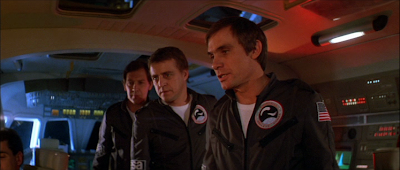The now-beautifully-colored Lifeforce is defined by an air of formality, one that is sustained throughout the course of the film. It is a constant and complete decorum of shot and camera that rules the experience of the film.
Within a film about functionality and profession, disrupted by the
chaos of being - by the fervor of curiosity, sex, our perceptions and beliefs - then the shipshape British cinematic economy is all too meaningful
and miraculously retained throughout, even at the film's most chaotic
heights and thus to increasingly impressive ends.
It's an exploration of superficial ranks and how this itself maps the motions of characters and the nature of their interactions. All this rendered by an ever-distanced camera and wry mode of storytelling, put into play by Hooper and O'Bannon.
This first instance of our time with characters - the scene currently being shown in stills - is a model of formality and, in a spectacular way, has the characters perform movements that are an initiation with us as partners: this is a scene of subtle relationship-creating, aka socialization, done through setting a rigid bar in camera demureness and allowing very neutral characters to relate to the viewer - that is, establish with us a sense of their social position - through their perspectival position (in relation to us). So here, along a fixed point of viewer perspective (a kind of three-fourths-angle view of the corridor and thus the entire line-up of crew members), we witness the delicate, regimented movements (the underlings seated, perhaps in order of importance... the superiors allowed to amble, walking the corridor, looming above the drones). In other words, a ritual of placements and movement subtly occurs here that imperceptibly is one of socialization, and - through pure mise en scene - remarkably involves the viewer.
We are being socialized into this work space, indoctrinated with knowledge immediately - through the pure visual, one pointedly perspectival (as Hooper always is) - of the positions and hierarchies of this work environment.
Lifeforce is the film equivalent of a cotillion (and its stunning ironic form almost makes that comparison approach literal a capacity). A social dance for which to reveal, or demarcate, social position.
Here in this space shuttle, the social ecosystem is one of pure professionalism (or is it? The narrative eventually begins to undercut the very idea…). But once Lifeforce, post-prologue, fully takes off, the world is shown to be a social dance of total entropy, a veritable whirligig-style cotillion. I'd like to think it casts no aspersions on the wildly promiscuous Space Girl, though, but warmly accepts her devastating hunger (and that of her converts) into the wild world of socialization - as it is so in reality. This formal, regimented baroque dance is one populated by perverts and sex zombies, and lo be it for us to demand it be otherwise (as such a thing is not to be). Lifeforce is the wonderful, sensitive, moderate confab between a Gone With the Wind cotillion, where order and arrangements reign, and any one of the fertility fetes seen in The Wicker Man, where sex is naughty but natural, nuclear but necessary. I truly think Lifeforce's ultimate message is: who hasn't ever felt like they've exploded into dust at one time or another? During a bad break-up (or bad get-together)? Socialization is messy. Lifeforce is the most understanding confabulation.
Derebridge enters, an ambulating superior down a long hall of subordinates. To his oh-so-surprise, he is hailed by one of them.
"Sir, this is odd."
The cut-away separates the entrance of superiors, as now another apparent managerial officer is seen following not far behind Derebridge, demanding to know what's up.
Anonymous top rank build one atop the other, the entrance regimented by editing: it is a roll call of rank being announced for entrance into the elegant patterned social dance.
The new person asks, "What's going on?" (and it is his last word).
Derebridge: "You chaps run an equipment check?"
Female crew member replies to Derebridge, "I've been checking every five minutes, sir."
Male crew member: "Radar states 150 miles."
Derebridge: "150 miles what?"
Male crew member: "Length."
"150 miles long!?"
Please divert your attention to this THAS ANNEX post on Carlsen's entrance: http://tobehooperappreciationsociety.tumblr.com/post/9189986632/lifeforce-1985-in-a-film-full-of-tonal
A nimble introduction, brilliant and hilarious, leads to a nimble cutaway, which leads to another ritualized entrance (of Carlsen) into the coterie of space-perverts or space-debutantes, depending how you look at it:
Midway into the dance, our trio of elite space socialites make a half-turn on their heels. The pecking order, by this point, has been made very clear: Railsback at the top, Derebridge supplanted, the gainfully-unidentified third officer now a meek, wordless shadow.
Notice how this third officer seems to have completely jumped positions from the previous moment quite all of a sudden...
I literally marvel. It's so marvelous, I don't even worry about intention.
The three stride forward with the camera in a final dance step that may as well be one of those elegant partner-exchanging hand-offs in a Baroque minuet dance, a trope which we've all seen in assorted period Shakespeare or Jane Austen movie.
Here, the commanders exchange one group of workers for another, partners in a dance, workplace "swinging."
The spaceship is a workspace which is a dance of position and post.
Conjugal dance and partnering, obligatory or otherwise, continues on as we see Carlsen confiding his deep contemplations to Derebridge, whether because he has a real relationship with the man or simply because he is his second-in-command, we do not know:
The shuttle itself gives the utmost erotic act of "movement-partnering" (aka, dance) to the derelict space object, riding up its length in imagery that can best be described, well, in non-dance terms... unless it's the closest lap dance one has ever gave. And I'm done for the day!



























































10 comments:
http://mubi.com/cast_members/177944
:)
Hello Anonymous! (:
I'm not sure what special key you may be suggesting Rousseau serves as, into the realm of art, as I am largely unfamiliar with him, but I look forward to the finding out! I just saw his cine-tract, Straub-Huillet collab Europa 2005 - 27 Octobre.
Perhaps his involvement with Straub & Huillet, or his practice of critique. Or maybe his MUBI quote being leveled: "When beauty is seen, one sees nothing." :)
Sorry, I don´t speak english, i am from Spain. But I can understand your posts. It´s a shame we can´t talk, because i am probably the biggest Tobe Hooper fan in the world, along with you, of course. I think he is one of the greatest (if not the grater) formalists in film history. I can´t thik in any other director with such an amazing, computational eye for visuals. He is an artist of the same caliber as Lang, Straub-Huillet, Bresson, Hithcock, Sternberg...
And for my suggestion of Jean-Claude Rousseau... i just think you are going to love it. :)
Oh, I love your blog. :)
It is a shame we can't talk, but it's a thrill to know of a fellow Hooper acolyte/cinephile. Your subliminal commentator presence has been quite brilliant, and I'll never forget Ne change rien. Seriously.
Love the recommendation so far - truly the best gift, a film-maker/scholar I don't know that deserves knowing.
Cheers! Best of wishes with your endeavors, hope to see you around here again, and keep fighting the good fight (the Hooper fight).
Hehe... Thanks!!
On the other hand, have you seen his tv movie "The Apartment Complex?. I can´t remember any thread about that, maybe i am wrong. Amazing film, i would love to read your opinion.
I have - I think it's very worthwhile, certainly unique in Hooper's career. I was indifferent to its somewhat weightless absurdity at first, but I warmed up on 2nd viewing, the romance and the portrait of a community coalescing suddenly jumping out at me. It's effervescent, and Amanda Plummer is great.
Would love to be talking about it on this blog, but it's literally non-existent digitally. Someday, though I love that you highlight it.
It´s a very weird film, like a bad, feverish dream. Sometimes I think that Hooper films real dreams, or nigthmares. There´s somethig wonderfully out of control, devoid of logic, in his films, but filmed with an exquisite sense of form (controlled chaos?). And the idea of the missing room (like in "Toolbox..." ) always blows my mind. And all the Freud stuff (dreams again... ) is very clever.
I downloaded it from torrent, but i don´t know if it´s still working.
And more recomendations :)
A genius:
http://www.imdb.com/name/nm0258977/
And...
http://www.youtube.com/watch?v=hpwivjJ3WOQ
There´s somethig in the films of this director (Juanma Bajo Ulloa) that reminds me a lot to Hooper. But maybe it´s difficult to find english subtitles.
I think he works very closely with instincts, and logical thinking definitely doesn't have any priority rule. As for "The Apartment Complex," it's a film about "controlled chaos" (social psychology, happenstance, government conspiracy), so this would be a case of material he takes on catching up/matching up with his innate style.
I think I've found some leads on that torrent. Thanks for the tip off!
Can you believe I haven't seen Spirit of the Beehive? Bajo Ulloa definitely seems to have a grasp of the exquisite, judging from the trailer. Tobe Hooper + Raoul Ruiz.
Good point. The image of the maze and the rats is a great metaphor of that.
"El espíritu de la colmena (1973)" is a masterpiece, and "El sur" and "El sol del membrillo" are even better, if that´s possible.
Spanish cinema!!.
As for Ulloa, I see some strongs similarities in his mathematical, architectonic sense of form.
Post a Comment